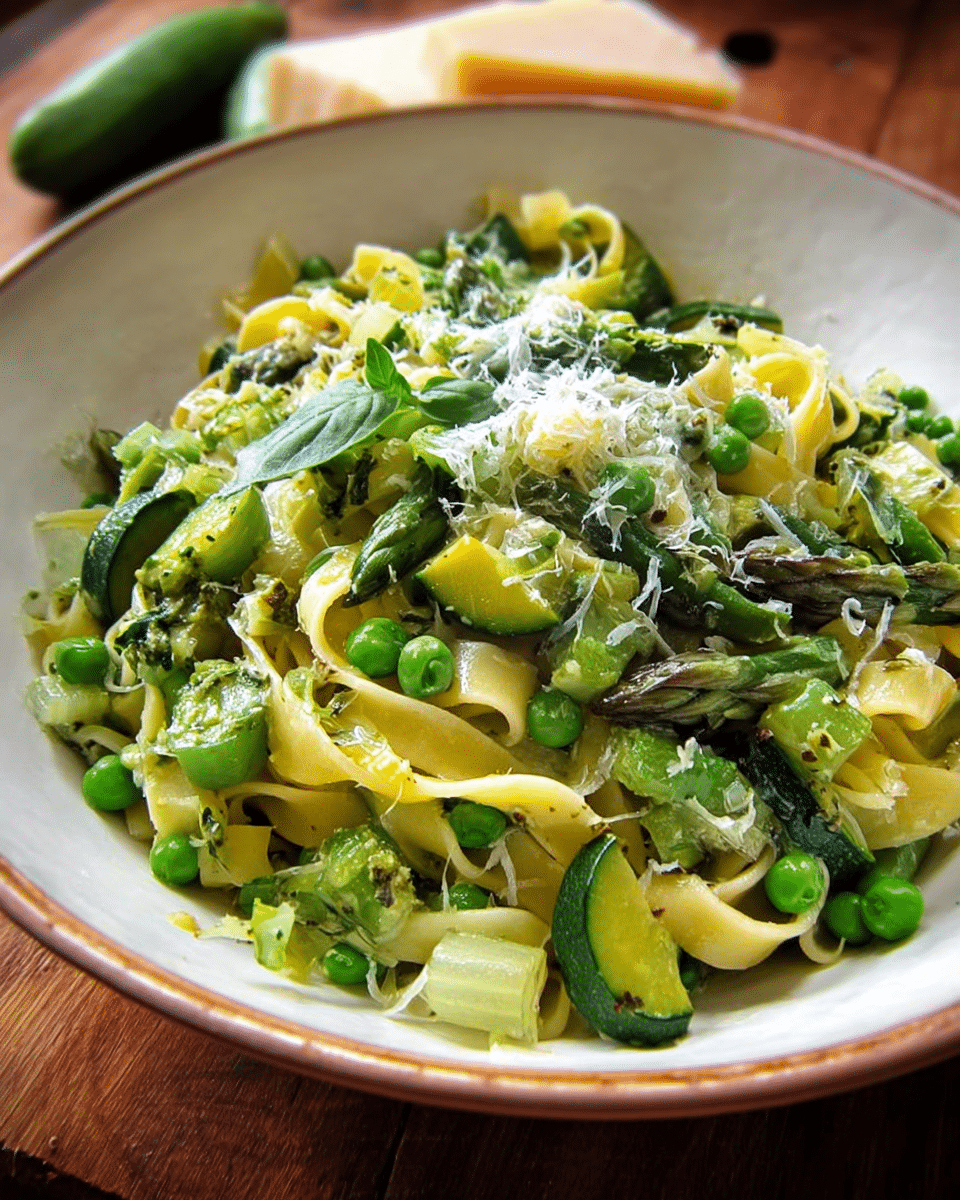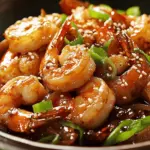The Pasta Primavera is the ultimate celebration of fresh, seasonal vegetables, blended beautifully with perfectly cooked pasta and a touch of Parmesan and lemon for brightness. It’s a dish that captures the essence of spring and summer on a plate.
This meal is a go-to for busy weeknights or relaxed weekend dinners, and it’s endlessly adaptable. Whether you’re cleaning out the fridge or heading to the farmers’ market, this dish lets you showcase your favorite produce in the most flavorful way. It’s light, satisfying, and simply beautiful.
Full Recipe:
-
12 oz penne or farfalle pasta
-
1 tablespoon olive oil
-
1 small red onion, thinly sliced
-
2 cloves garlic, minced
-
1 zucchini, sliced into half-moons
-
1 yellow squash, sliced
-
1 red bell pepper, julienned
-
1 cup cherry tomatoes, halved
-
1 cup broccoli florets
-
1/2 cup frozen peas, thawed
-
1/2 teaspoon crushed red pepper flakes (optional)
-
Salt and freshly ground black pepper to taste
-
1/4 cup grated Parmesan cheese
-
2 tablespoons chopped fresh basil
-
Juice of 1/2 lemon
Directions:
-
Bring a large pot of salted water to a boil. Cook the pasta according to package directions until al dente. Drain and set aside.
-
In a large skillet, heat olive oil over medium heat. Add the red onion and garlic, sauté until fragrant, about 2 minutes.
-
Add the zucchini, squash, and bell pepper. Cook for 4–5 minutes until slightly softened.
-
Toss in broccoli and cherry tomatoes, cooking for another 3 minutes. Add the peas last, stirring to combine.
-
Sprinkle in crushed red pepper flakes if using, and season with salt and black pepper to taste.
-
Add the cooked pasta to the skillet, tossing gently to coat with the vegetables.
-
Stir in the Parmesan cheese, lemon juice, and fresh basil.
-
Serve warm with additional Parmesan and basil, if desired.
Prep Time: 15 minutes | Cooking Time: 20 minutes | Total Time: 35 minutes
Kcal: 390 kcal | Servings: 4 servings
The Essence of Pasta Primavera
Pasta Primavera is more than just a vegetarian pasta dish—it’s a tribute to the bounty of spring and early summer. Bursting with vibrant, seasonal vegetables and tossed in a light sauce, this dish captures the spirit of freshness, simplicity, and balance. Originally conceived in the United States during the 1970s, Pasta Primavera has become a modern classic, enjoyed across the globe for its versatility and flavor.
Contrary to what its Italian name might suggest, “Primavera”—which translates to “spring”—is not a traditional dish from Italy. It was actually born in North America, reportedly at Le Cirque in New York City, where it became an unexpected hit and eventually one of the most iconic pasta dishes to grace fine-dining and home kitchen tables alike.
Why Pasta Primavera is Loved by Many
There are countless reasons Pasta Primavera is a staple in many households. Its colorful presentation immediately appeals to the eyes, while the medley of textures—from crisp-tender vegetables to al dente pasta—offers a delightful contrast. The flavor profile is bright, fresh, and comforting, with a mild garlic base, hints of sweetness from the bell peppers or cherry tomatoes, and a savory touch from the cheese.
What makes this dish particularly beloved is its incredible flexibility. It can be made with virtually any combination of vegetables, allowing home cooks to use up what they already have or highlight fresh produce from a local farmer’s market. It’s vegetarian by default, but easily adapted to vegan, gluten-free, or protein-boosted versions with just a few swaps.
Seasonal Star: A Celebration of Spring Produce
Pasta Primavera thrives on the idea of using vegetables that are in season. In the spring and early summer, this can include zucchini, yellow squash, asparagus, peas, broccoli, cherry tomatoes, and fresh herbs like basil or parsley. The vegetables are typically sautéed until just tender, preserving their natural sweetness and crunch.
Because of this emphasis on freshness, Pasta Primavera is not only delicious but also nutrient-dense. It’s packed with fiber, vitamins, and antioxidants—without relying on heavy cream sauces or overly rich elements. The lemon juice and herbs brighten the flavor, making it feel light and refreshing even while being satisfying.
A Healthy Choice That Doesn’t Compromise Flavor
One of the standout aspects of Pasta Primavera is its nutritional profile. The dish is naturally low in saturated fats and high in dietary fiber, thanks to the wide variety of vegetables included. It’s a great source of Vitamin A, Vitamin C, potassium, and even plant-based protein when paired with whole grain or legume-based pasta options.
Additionally, many people find Pasta Primavera to be a great “reset meal.” It’s light on the stomach yet filling enough to be the centerpiece of a nourishing lunch or dinner. If you’re aiming for a healthier lifestyle, this pasta dish lets you enjoy carbs and comfort while still eating clean.
Make It Your Own: Variations and Customizations
Pasta Primavera is one of the easiest recipes to modify to suit dietary needs or preferences. Want to make it vegan? Skip the cheese or use nutritional yeast or a vegan Parmesan alternative. Prefer a protein-rich option? Add grilled chicken, shrimp, or even chickpeas for an extra boost.
It can also be made gluten-free by simply swapping out the pasta for a certified gluten-free version. For low-carb or keto-friendly versions, spiralized zucchini or spaghetti squash can replace the pasta altogether. Those watching sodium can control it by reducing cheese or seasoning with herbs and lemon instead.
The sauce, traditionally light and based on olive oil, garlic, and sometimes a splash of lemon or broth, can also be adjusted. Some cooks opt for a touch of cream, while others prefer a pesto or tomato-based alternative. The idea is to enhance the vegetables without overshadowing them.
Tips for Perfecting Your Pasta Primavera
1. Use Fresh, Crisp Vegetables: Avoid overcooking your vegetables—aim for crisp-tender. This maintains their texture and vibrant color, adding to the overall appeal of the dish.
2. Cook Pasta Al Dente: The pasta should have a slight bite to it, especially because it will often continue to cook slightly when tossed with hot vegetables in the skillet.
3. Don’t Overdo the Oil: A light touch with olive oil helps the dish feel clean and balanced. You want just enough to coat the pasta and vegetables, not drown them.
4. Finish with Acid and Herbs: A splash of lemon juice and a handful of fresh basil or parsley can elevate the entire dish, adding brightness and freshness.
5. Use a Variety of Colors: Choosing vegetables with different colors not only improves nutritional value but also makes the dish visually stunning—think red bell peppers, green zucchini, yellow squash, and purple onions.
Serving Suggestions for Any Occasion
Pasta Primavera is a flexible dish that can serve as either a main course or a side. As a main dish, it pairs well with crusty bread, a glass of white wine, or a side salad. It’s great for lunch meal-prep, potluck gatherings, or even dinner parties when you want to impress with a plant-forward option.
When served as a side, it works beautifully next to roasted chicken, grilled salmon, or pan-seared tofu. It also makes an ideal addition to spring-themed menus or Easter celebrations, thanks to its seasonal ingredients and vibrant aesthetic.
For those who like to meal prep, Pasta Primavera holds up well in the fridge for 2–3 days. Reheat gently to avoid making the vegetables mushy. It can even be enjoyed cold as a pasta salad variation—especially with a light vinaigrette.
The Visual Impact of Pasta Primavera
In food presentation, color matters. Pasta Primavera makes a stunning impression on the plate, especially when served in shallow white bowls that contrast against the rainbow of vegetable hues. A light sprinkling of Parmesan and a few basil leaves add the finishing touches.
If you’re photographing the dish for your food blog or social media, use natural lighting to highlight the glistening vegetables and textures. A linen napkin and rustic flatware will reinforce the dish’s home-cooked authenticity and freshness.
Global Influence and Adaptations
Although Pasta Primavera is American in origin, it has been embraced globally for its versatility. In some parts of Europe, it’s served with locally available vegetables like fava beans or artichokes. In the Mediterranean, olives or sun-dried tomatoes might make an appearance.
Even in Asia, fusion versions have appeared, incorporating soy sauce, sesame oil, or tofu. This reflects the dish’s core identity: a flexible foundation that allows for endless creativity based on local ingredients and preferences.
Conclusion: Why Pasta Primavera Deserves a Place at Your Table
Pasta Primavera is a dish that celebrates simplicity, seasonality, and health. It’s a reminder that with just a few fresh ingredients, you can create something visually beautiful, nutritionally rewarding, and deeply satisfying. Its ability to adapt to different dietary needs makes it a crowd-pleaser, whether you’re cooking for family, entertaining guests, or preparing weekday lunches.
More than just a recipe, Pasta Primavera is a concept—one that encourages you to explore your local produce, experiment with flavors, and embrace the beauty of plant-forward meals. In today’s food culture that values both taste and wellness, Pasta Primavera hits all the right notes.
Whether you’re a beginner looking for a simple, impressive dish or a seasoned home cook seeking a new favorite, this pasta is guaranteed to inspire and nourish.






